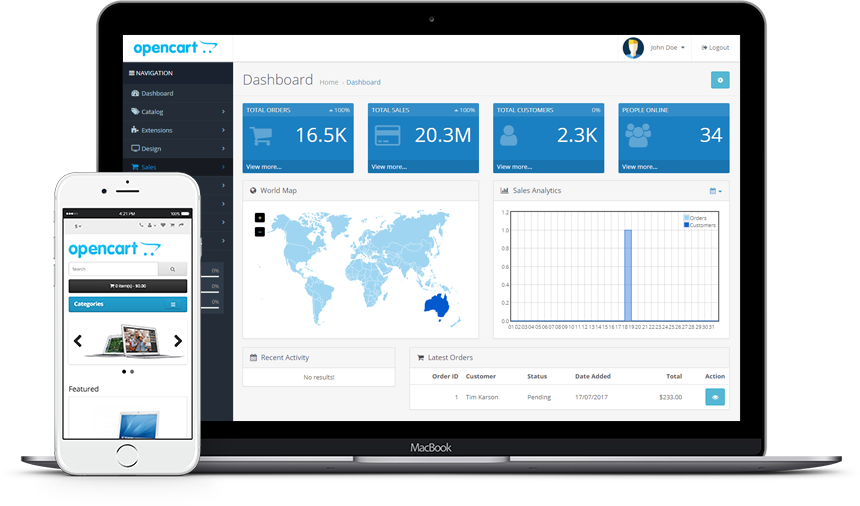Create a fully customizable free eCommerce website
The eCommerce landscape is witnessing phenomenal growth, with global e-sales surpassing 5.2 trillion USD in 2021. This underlines the importance of retailing online for business owners who desire to reach out to more qualified leads, cover uncharted territories, fuel brand growth, and sustain revenues.
Competition is intensifying, and your brand's survival, irrespective of whether it's offline or virtual office, will become difficult without an online presence. You need an eCommerce website to promote your products and attract targeted customers' attention. For instance, educational platforms and businesses can enhance their offerings by including options like buy coursework help to support students in achieving their academic goals while driving more traffic and engagement to their site.
While building a free and customizable eCommerce website, it's essential to ensure that your site is secure from potential threats. A reliable WordPress security plugin can provide robust protection, safeguarding your online store and customer data effectively.
This post explores the steps to create a customizable eCommerce website for free.
Create Your Ecommerce Website For Free
You need not be a coding specialist to build a functional eCommerce website. The task is simplified by online website maker tools that let you build and tailor the design of your website and start selling immediately.

The actionable steps in materializing your online store plans have been discussed below to help you mint money quickly. However, to ensure long-term success, it's essential to not only focus on website development but also integrate effective marketing strategies. An ecommerce marketing agency can help you optimize your site's user experience while also crafting targeted marketing campaigns to drive traffic and boost sales.
Choose An Appropriate Ecommerce Platform and Domain Name
Your online store's framework has to be built with a software application that offers ease of management and ensures optimal customer engagement. For a free and scalable website, you will need an Open Source platform that offers the following features:
Free installation and unlimited customization
Free source code with a license to manipulate scripts. If you're specifically looking to create a fitness website, consider using a fitness website builder designed for personal trainers and fitness professionals
You can consider the Software as a Service (SaaS) platform that comes for a monthly subscription fee. It doesn't suffer any drawbacks and facilitates safe payment transactions and quick checkouts. Exercising creative control over a site's architecture becomes easy.
Some essential things are outlined below:
Proven uptime to facilitate optimum site availability
Makes product pages load quickly for the best customer experience
Capable of handling expected site traffic, particularly during peak hours or festive sales
Scalable to cope with future growth requirements
Mobile responsive with facility for geolocation
Offers maximum security for safeguarding sensitive information of customers and your site
After this, you have to select a marketable domain name. Remember the following things while choosing one:
Don't be extra creative with the domain name, as prospective buyers may find it difficult to remember your site's name.
The name should be easily spellable, making it easier for customers to recommend your store to others.
Make sharing your store's web address simple by avoiding numbers or hyphens in the domain name.
Avoid names resembling other brands, as the search engine may erratically divert leads to other sites with better SERP (Search Engine Result Page) ranking.
Keep the length within 6 to 14 characters.
Host Your Website
Your eCommerce site's data has to be stored on servers that can be hosted off-site (Cloud) or on-premise (business-owned). If you are on a shoestring budget, consider cloud hosting or managed VPS hosting offered by SaaS.
For a small fee, everything from site updates, security upgrades, and sufficient space provision to the application of patches shall be managed by the SaaS providers.
Hire A Seasoned Web Developer
An experienced web developer with a proven track record of delivering prestigious projects can leverage his technical skills to help set up your store in a tailored mode.
Communicate your vision and budget to the:
- developer so that s/he can do perfect justice to your ambitions.
- Integrating a transkriptor tool can help document planning calls
- during your store setup, ensuring clarity and alignment throughout
the development process.
Select A Versatile and Customer Friendly eCommerce Template
Templates are readymade webpage themes that you can customize per your requirements and vision with almost zero coding. You can consider to utilize AI website builder like Codesi to start building your website. Some of the features that you must look for in a good template have been outlined below:
Intuitive user interface with ease of navigation facilitated by visual cues to help customers reach the desired product page.
Sufficient placeholders for including product images and videos, narrating your brand's story, and providing concise yet informative descriptions.
Tailoring option to sync the webpages' font, colors, and style with your brand's signature style.
Flexibility for changing product displays, embedding social media buttons, and integrating third-party apps to enhance the e-store's functionalities.
Functional shopping cart feature allowing for adding multiple products, wish list cataloging and jumping to the checkout page.
Start Adding Your Products
Set up your product pages by prioritizing the display of your new and premium products. Enhance the appeal of your products with the following elements.
(i) Informative product descriptions
Highlight the dimensions, utility, colors, textures, important details, place of use, and purpose of each product
Use simple, keyword-integrated, short-sentenced, and jargon-free descriptions for ease of understanding and indexing by search engine bots
(ii) Images and Videos of the Product
Use high-resolution multiple images and videos to showcase your product from various perspectives and enhance its visual appeal.
Keep the size of all pictures uniform and mobile responsive (adapts automatically to the dimensions of the viewer's device screen)
Walk customers through the mode of use and real-life examples of product usage with videos.
You can use a good video editor to convert product image to videos and make the product more tantalizing. Alternatively, if you need to generate image content to enhance your product pages, using a tool designed for this purpose can be highly effective.
(ii) Product Categorization
Facilitate ease of search by categorizing products in groups based on common features or shared functionalities like electronics, home appliances, etc. Leverage advanced AI techniques like few-shot classification to automatically categorize products based on customer feedback and reviews ensuring accurate and up-to-date product listings.
Provide ample filters to make it easier to sort products based on brands, prices, customer ratings, etc.
To further enhance the impact of your product descriptions and the overall content on your product pages, consider leveraging content examples crafted by professional paper writers. These experts specialize in creating compelling, persuasive content that not only informs but also engages potential customers. By reviewing professional examples, you can learn how to effectively convey the uniqueness and benefits of your products, which can significantly improve your conversion rates.
This approach will ensure that your product descriptions are not only informative and SEO-friendly but also tailored to meet the expectations of your target audience. You can find these expert examples online, offering you a practical resource for refining your product content strategy through this digital product development company.
Set Up Payment Gateways
Use simple, secure, and widely used payment gateways to make it convenient for customers to pay for products in a shopping cart. Some important things that you must factor in have been detailed below:
Use merchant gateways that offer complete security (follow Payment Card Industry Data Security Standard and have an SSL certificate) for confidential and sensitive financial credentials of customers
Use in-page checkout functionality maximally to prevent customers from being redirected to a third-party site for payment
Use approved data encryption techniques if off-site payment processing can't be avoided
Inform customers of fees applicable for processing payments and refunds
Finalize Shipping Modalities
Post payment, your customers will want prompt shipping of purchased products. Spell out your shipping policy clearly by keeping the following things in perspective:
Shipping charges
Carriers entrusted with product delivery
Total shopping value to qualify for free shipping
Provision of shipping to offshore locations
Packaging policy
Confirmation email
Process of checking updates on product delivery
Your contact details and helpdesk numbers
Conduct Pilot Tests Before Launching Your eCommerce Website
Before deploying your your fitness website builder, conduct a test run to check if everything is working satisfactorily. Make pilot runs on various popular web browsers.
Ensure that the site's time zone, language, taxation details, etc., have been correctly set.
Launch Your Website
Your fully functional and well-customized e-store is now ready for launch.
Deploy it over the web and offer the best experience to all site visitors to increase your brand reputation, sales and profit.
How To Market Your Online Store Using Video
You can spread the word about your eCommerce site through video marketing which plays a crucial role in digital marketing. To optimize your site promotion, you can use the following:
'About Us' video in welcome emails sent to targeted customers
Social media videos to engage prospects and motivate them to like and share your content
Explainer videos to highlight your site products and how and where to use them
FAQ videos to address the pain points of customers
Customer testimonial videos to share experiences, reviews, satisfaction levels, and feedback from past customers
Reminder videos to motivate customers who had abandoned their shopping carts or who could not place orders due to a shortage of stock
Product videos to demonstrate the usage, functionalities, and specifications of products put up for sale
You can use a video editor to convert product images to videos for the best outcome. However, for influencer videos, create a clear policy with video release terms. browse legal templates on Freshdox for sample templates and consult legal professionals. In case you need an eCommerce website to promote your products such as personalized whiskey gifts and attract targeted customers' attention.
While you are constructing your eCommerce website for free and the way you want, it is important to keep in mind methods that improve your brand awareness and outreach. One effective means of increasing your visibility online is social proof which is largely available via social networking websites, and Instagram is one of the most important. Customers’ engagement is one of the aspects that helps viewers to trust your brand, which is why so many people choose to buy instagram likes, to establish credibility almost instantaneously. If your business has a strong Instagram following, it means that traffic to your eCommerce store is likely to increase, therefore boosting conversions and customer confidence.
It is further enhanced by the fact that Instagram has been integrated into the website in such a way that popular posts and the general look of the brand are in sync with the other social media platforms. Marketers can now use high engagement posts from Instagram as part of their marketing strategy to differentiate eCommerce businesses from other businesses in the space, regardless of whether they are starting a new or existing store.
Conclusion
You can easily create and launch your eCommerce website to optimally attract the attention of targeted customers with the steps mentioned above. Keep checking your hosting platform's analytics feedback to understand customers' responses and convenience levels. Tweak your page settings based on insights to optimize customers' browsing and purchasing experience.



Login and write down your comment.
Login my OpenCart Account